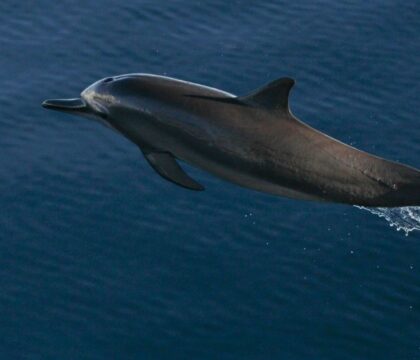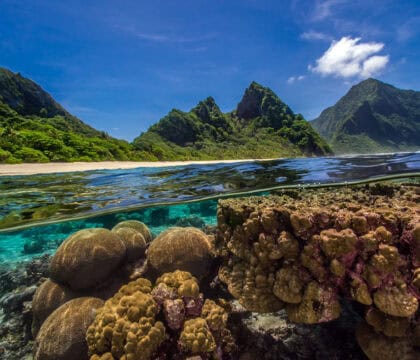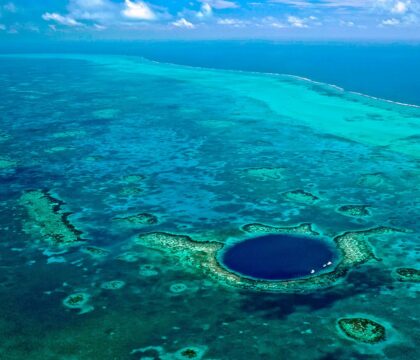March 19, 2025 • Travel Ideas
The boat departs at daybreak from the sandy banks of ‘Utangake, an island within the Vava’u region in the northeastern corner of the Kingdom of Tonga. Though these picturesque islands are ringed by stunning reefs, the boat, filled with eager tourists clad in snorkeling masks and wetsuits, heads further offshore where the swells gently rise, along with a palpable sense of anticipation.
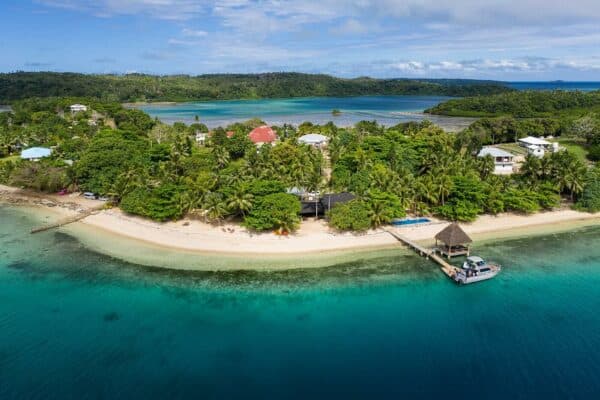
Tonga’s ‘Utungake Island offers the perfect departure point and adventure hub for exploring the surrounding South Pacific waters and swimming with humpback whales. © Doug Perrine
The captain scans the horizon looking for clouds of water vapor bursting from the surface – a sure sign that members of the famed “Tongan Tribe” of southern humpback whales are nearby. These whales gather annually in Tonga to mate, birth, rest, and rear their young after a long journey from their feeding grounds off of Antarctica – one of the longest migrations of any mammal, and one that serves an essential ecological function. Their annual presence in the tropical, equatorial waters of Vava’u also makes Tonga one of the best places in the world to swim with whales.
Once the captain finds the humpbacks and confirms it’s safe to swim, it’s time to get in the open ocean. Depending on what the whales are doing, travelers may have to swim across sometimes choppy ocean swells (affectionately called the “whale sprint”) to stay alongside their guide, who tries to station themself near the whales. Often the first thing you will see while gazing into the ocean’s abyss is a strip of light in the deep. This is the sun’s reflection off the underbelly of a whale, explained Rosie Jeffrey, Oceanic Society’s manager of strategic partnerships and a naturalist who leads expeditions to Tonga.
That beam of light soon transforms into a humpback whale as they swim towards the surface for air. Their enormous size and power regularly leave tourists in awe of their beauty and grace. Calves typically weigh around 1,400 pounds. Fully grown humpbacks span nearly 60 feet long and weigh up to 40 tons.
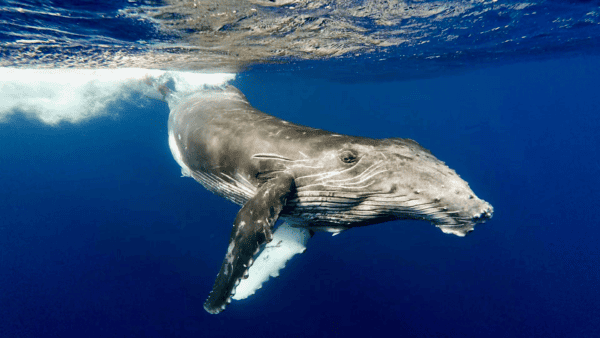
Tonga offers one of the most intimate wildlife experiences in the world, where curious humpbacks will regularly swim up to tourists. © Rosie Jeffrey
“I don’t think anything can really prepare you for that until you’re just experiencing it,” said Rosie.
Most often travelers will see a mother with a calf. The calves, who can be playful and curious as they explore their bodies and the world, will sometimes swim closely by entranced snorkelers as they come up for air. Calves are also the ones most likely to breach, spiraling themselves through the air, or to slap the water playfully with their massive flukes and fins – like a child at a playground under the watchful gaze of their mother.
“Every mom and calf pairing has their own kind of personality,” explained Rosie. Some humpbacks will notice humans and swim away, preferring their privacy. But others will be curious, especially later in the season after the calf has gained more strength and is starting to explore the surrounding world – and when the mothers are less protective.
Meanwhile, male humpbacks generally stick to themselves or are sometimes seen in packs competing for a mate. Lucky snorkelers may hear a male humpback sing – a hauntingly beautiful melody that echoes across the ocean up to 10,000 miles. These songs, which are meant to attract a mate, are unique to each group of whales and are passed down from generation to generation. Scientists even recently found that whale songs are structured similarly to the human language, with “word-like” elements that are repeated.
While whale watching the legendary acrobatics of humpbacks from the deck of a boat is an all-time classic experience for ocean lovers, actually swimming with humpback whales offers a unique encounter that often comes with a shift in perspective.
One moment in particular will live on forever for Rosie. During an Oceanic Society expedition to Tonga, she led a group of travelers into the South Pacific waters where they had spotted a pair of humpback whales. Rosie separated herself from the group to film the travelers as they experienced a once-in-a-lifetime wildlife encounter, but instead, she found herself the center of attention. A calf, rising from the deep, veered directly to Rosie and spun playfully around her.
“I was within inches, and it just looked at me, and we gazed into each other’s eyes,” reflected Rosie, “When you look into the eye of a whale, it changes you.”
The experience left her with an overwhelming sense of connection to the natural world, and her place within the ecosystem. “You are a guest to their world,” she explained, “I’m an outsider trying to learn about this world. Just being able to witness them in their natural habitat is really, really humbling.”
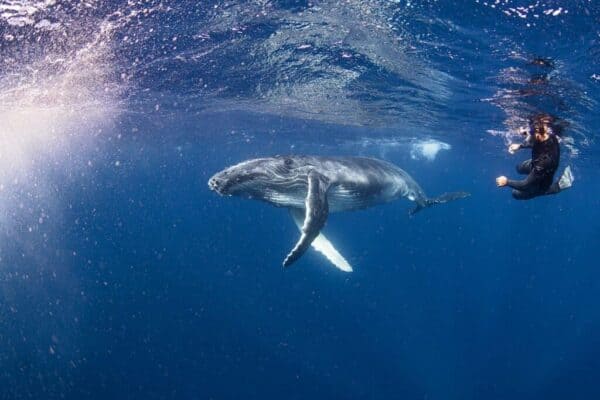
A humpback whale calf swims near an Oceanic Society traveler in Vava’u, Tonga. © Doug Perrine
But the intimate moment with the calf also left her with a profound sense of wonder. Not long ago, before they were offered modern day protections, this very same group of humpback whales had been hunted to near extinction by industrial whalers who slaughtered them off the coast of Antarctica as they fed on krill.
“The fact that they are even curious about humans is mind-boggling,” she said, “It doesn’t seem like that historical slaughter has impacted them as much as you might think it would have.”
From Whaling to Swimming with Humpback Whales
Industrial whaling wrought havoc on global whale populations during the 20th century; some scientists estimate that more than 2.9 million whales were slaughtered. The Tongan Tribe in particular suffered: their pre-whaling numbers peaked at 10,000, but by 1964 they had been reduced to just 250 humpbacks.
The Tongan people, who have ancient cultural ties to the whales, had for centuries practiced subsistence whaling, where one whale would feed an entire community. But despite this tradition, with humpback numbers plummeting, Tonga became one of the first countries to ban commercial whaling in 1978. A decade later, in 1986, the International Whaling Commission banned commercial whaling internationally to protect several whale species, including humpbacks, from extinction.
Since international bans on whaling, humpback populations have generally improved – yet many threats remain, such as bycatch and ship strikes. Today the Tongan Tribe is estimated to be around 1,000. Other groups of humpbacks have repopulated more dramatically, and scientists are unsure why the Tongan Tribe has seen relatively modest recovery, explained Rosie.
Tongans, with an economy and culture deeply tied to the ocean, realized that the majestic humpbacks yielded lucrative ecotourism potential – especially for the unique opportunity to swim with humpback whales. “It became clear that a whale is worth much more to the community alive than it is dead,” said Rosie.
Today, the whale watching industry drives much of Tonga’s tourism. It contributes more than $2.1 million to the Tongan economy each year and has created over 13,000 ecotourism jobs.
Ecotourism, when implemented ethically, can protect nature and generate income for economies that may otherwise exploit natural resources – creating these opportunities is the central ethos of Oceanic Society’s sustainable travel model. Tonga serves as a case study in how ethical whale watching not only protects the whales and generates income, but also how strict regulations actually improve the experience for travelers – a key reason Oceanic Society has led expeditions to Tonga for over 20 years.
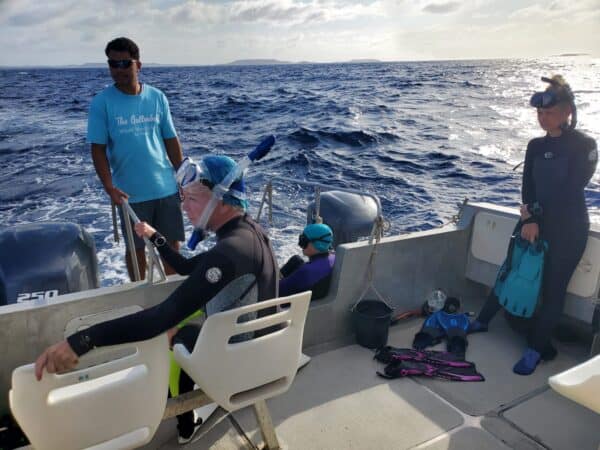
Oceanic Society travelers and guides prepare to plunge into the choppy South Pacific waters in search of humpbacks. © Rosie Jeffrey
“In Tonga, you can only have four people in the water at a time,” said Rosie, as she explained the process of swimming with whales in Tonga, “So it’s much more personal.” But the size of the group also benefits the humpbacks, which can facilitate a better experience for everyone.
Humpbacks generally perceive groups of humans as one being, Rosie explained. If there are many people in the water – and if they are spread out – humpbacks may perceive them as a threat, and may leave as a result.
“It’s more regulated, but it’s also better for the whales,” she said, “And if it’s better for the whales, they’re going to be more relaxed,” and as a result, more curious about people.
Even though the conditions are ideal in Tonga to swim with humpback whales, Rosie emphasized that people must adopt a sensitive mentality for encountering whales in this unique circumstance – which will ensure the experience continues to build positive connections between people and nature, rather than create something transactional and exploitative: “We are guests in their environment,” she said.


